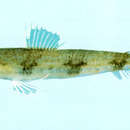Trophic Strategy
provided by Fishbase
Occurs in inshore waters of the continental shelf (Ref. 75154).
- Recorder
- Auda Kareen Ortañez
Biology
provided by Fishbase
Ranges from coastal sand flats to deep off-shore (Ref. 48635). Prefers deeper waters (Ref. 30573). Sold fresh or dried salted in markets (Ref. 3520). Minimum depth reported from Ref. 30573.
Importance
provided by Fishbase
fisheries: minor commercial; price category: medium; price reliability: very questionable: based on ex-vessel price for species in this family
Comprehensive Description
provided by Smithsonian Contributions to Zoology
Synodus macrops Tanaka, 1917
Synodus macrops Tanaka, 1917:38 [Japan].
MATERIAL EXAMINED.—WESTERN AUSTRALIA (2): AMS (uncataloged). GUADALCANAL ISLAND (2): BPBM 15570. SOUTH CHINA SEA (3): USNM 136225 (1); CAS 30749 (2). FORMOSA STRAIT (5): NTU 00228 (1),00448 (1); CAS 15930 (2), 29998 (1). JAPAN (Inland Sea-Pacific) (26): USNM 217778 (9); FAKU 1056, 2063, 2263, 2264, 2265, 2266, 2267, 2268, 2269, 2270, 2272, 2273, 2274, 2277, 4322, 4757, 4760 (1 specimen each).
DIAGNOSIS AND COMPARISONS.—A species of Synodus with the following combination of characters: dorsal-fin rays (branched and unbranched) 11–12 (usually 12); anal-fin rays 10–11 (usually 10); pored lateral-line scales 51–55 (usually 54); transverse scale rows 3.5/5; vertebrae 51–55 (usually 54); combined dorsal and anal procurrent rays 20–26; anterior palatine teeth not longest and not in a discrete group; peritoneal spots 6–7; posterior pelvic process narrow; peritoneum pigmented dark brown; tip of lower jaw fleshy.
The pigmented peritoneum of S. macrops separates it from all known species of Indo-West Pacific Synodus except S. kaianus. The vertebral count of S. macrops is much lower than S. kaianus (51–55 vs. 58–63).
DESCRIPTION.—Dorsal-fin rays 11–12; anal-fin rays 10–11; pectoral-fin rays 12; pelvic-fin rays 8; procurrent rays 20–26, dorsal 11–14, anal 9–12; lateral line continuous, 51–55 pored scales; scale rows above lateral line from dorsal origin 3.5; scale rows below lateral line to anal origin 5; predorsal scales 15–16; rows of cheek scales 4; vertebrae 51–55, peritoneal spots 5–6.
Percentages of Standard Length: Mean (range); head length 26.9 (24.2–29.9); snout length 5.8 (5.4–7.0); upper jaw length 15.8 (13.6–17.9); diameter of bony orbit 7.7 (5.9–9.8); least width of bony interorbital 2.6 (2.2–3.1); snout to dorsal origin 41.8 (39.2–45.9); snout to adipose origin 86.3 (82.6–91.6); snout to anal origin 76.2 (72.3–79.9); snout to pelvic insertion 35.8 (32.9–38.6); snout to pectoral insertion 26.2 (23.9–29.1); first-dorsal-ray length 11.1 (9.5–13.2); longest-dorsal-ray length 15.1 (12.1–16.7); pectoral-fin length 13.3 (10.6–15.0); pelvic-fin length 19.8 (18.7–21.5); dorsal-fin base 12.5 (10.4–14.2); anal-fin base 10.1 (8.8–12.3); based on 20 specimens 51.9 to 175.0 mm, SL.
Body fusiform, head somewhat depressed, caudal region a little compressed. Large cycloid scales on body, cheeks, and operculum, postoral portion of cheeks scaly. Snout sharply pointed, broader than long; the anterior nostril on each side bearing a long triangular flap, extending well beyond margin of nares when depressed anteriorly. Interorbital space concave, occipital region bony. Palatine teeth in an elongate V-shaped pad, teeth pointing backwardly, those in front not largest and not in a discrete group. Lingual teeth well developed, those on free end of tongue largest and about 30 in number; free end of tongue narrow, 2–3 teeth across distal half. Teeth caniniform, larger teeth with arrow-shaped tips. Pectoral fins reaching a line from base of pelvic fins to origin of dorsal fin. Outer pelvic ray unbranched and short, fifth branched ray (sixth ray) longest. Posterior bony process of pelvic girdle narrow. Peritoneum brown to black.
COLOR PATTERN.—Dorsum without discrete patches of pigment in preserved material, uniformly darker than ventral surface. Three conspicuous lateral dark X-shaped patches with smaller, poorly defined dark patches between. One X-shaped patch at level of origin of dorsal fin, one near middle of body, one at level of anal fin. Fins pale.
DISTRIBUTION AND HABITAT.—Synodus macrops is recorded from Western Australia, Guadalcanal Island, South China Sea, Formosa Strait, and Japan, indicating a wide distribution in the West Pacific and easternmost Indian Ocean. Depth of capture data for six collections record this species from 35 to 173 m with a mean depth of 101 m (Guadalcanal specimens from 35 m).
- bibliographic citation
- Cressey, Roger F. 1981. "Revision of Indo- West Pacific lizardfishes of the genus Synodus (Pisces: Synodontidae)." Smithsonian Contributions to Zoology. 1-53. https://doi.org/10.5479/si.00810282.342
分布
provided by The Fish Database of Taiwan
分布於印度-西太平洋海域,西起紅海,東至阿達曼海,北至日本,南至澳洲。臺灣僅少量分布於南部及東北部海域。
利用
provided by The Fish Database of Taiwan
偶為底拖網或延繩釣捕獲,可食用。
描述
provided by The Fish Database of Taiwan
體圓而瘦長,呈長圓柱形,尾柄兩側具稜脊。頭較短。吻尖;上下頜等長。口裂大,上頜骨末端遠延伸至眼後方;頜骨具銳利之小齒;腭骨前方齒與後方齒等長,不自成一叢。體被圓鱗,頭後背部、鰓蓋和頰部皆被鱗;側線鱗數49-55;側線上鱗數3.5。單一背鰭,具軟條10-12(通常為11);有脂鰭;臀鰭與脂鰭相對,具軟條9-11(通常為10);胸鰭長,末端延伸至腹鰭起點與背鰭起點之連線,或超越之;尾鰭叉形,上葉等長於下葉。體呈淡黃褐色,體側具四個"X"或"Y"型的暗斑。
棲地
provided by The Fish Database of Taiwan
主要棲息於沿近海靠近礁盤至外海較深之砂泥底質海域。屬肉食性,以小型魚類及甲殼類為主。通常在砂地上停滯不動,身上的花紋是很好的偽裝,有時會將整個身體埋入砂中而只露出眼睛,等候獵物游經時,躍起吞食。
Triplecross lizardfish: Brief Summary
provided by wikipedia EN
The triplecross lizardfish (Synodus macrops) is a type of lizardfish that lives mainly in the Indo-West Pacific.
- license
- cc-by-sa-3.0
- copyright
- Wikipedia authors and editors
Description
provided by World Register of Marine Species
Prefers deeper waters. Sold fresh or dried salted in markets (Ref. 3520).
Froese, R. & D. Pauly (Editors). (2023). FishBase. World Wide Web electronic publication. version (02/2023).
- license
- cc-by-4.0
- copyright
- WoRMS Editorial Board

